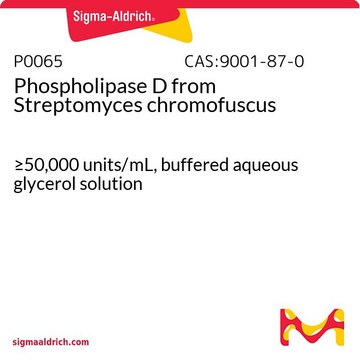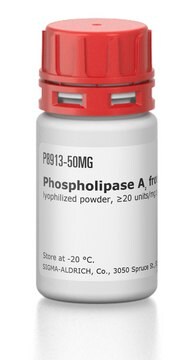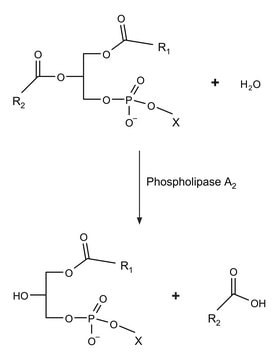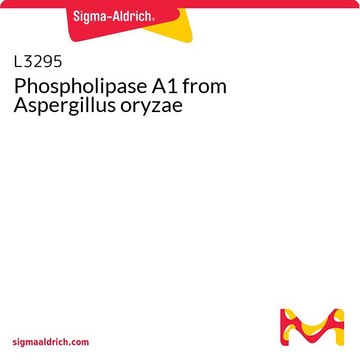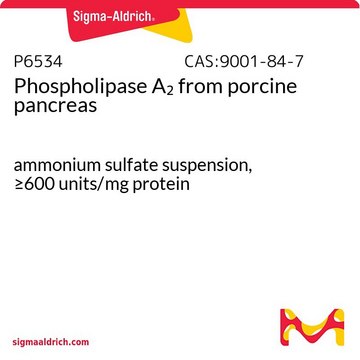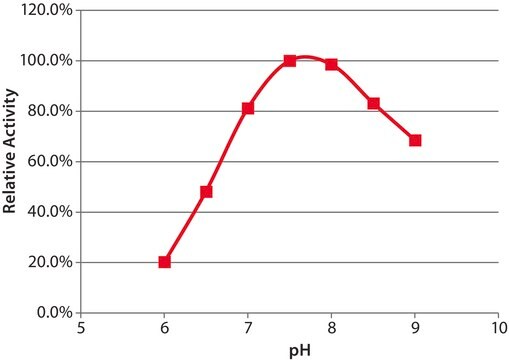P8398
Phospholipase D from cabbage
Type IV, lyophilized powder, ≥100 units/mg solid
Sinonimo/i:
Lecithinase D, Phosphatidylcholine phosphatidohydrolase, Phospholipase D from white cabbage
Autenticatiper visualizzare i prezzi riservati alla tua organizzazione & contrattuali
About This Item
Prodotti consigliati
Tipo
Type IV
Stato
lyophilized powder
Attività specifica
≥100 units/mg solid
Composizione
Protein, ~25%
Temperatura di conservazione
−20°C
Cerchi prodotti simili? Visita Guida al confronto tra prodotti
Descrizione generale
Phospholipase D (PLD) from cabbage comprises the C2 domain, PLD superfamily specific conserved regions (I–IV) with HxKx4Dx6GSxN (HKD) motif. Structurally, it is a barrel-shaped monomer bound to calcium ions.
Applicazioni
Phospholipase D (PLD) is used to hydrolyze the phosphate bonds of phospholipids and sphingomyelin to give the corresponding phosphatidic acid. It has also been used to study metabolic labeling and direct imaging of choline phospholipids in vivo by measuring propargyl-Cho incorporation. Furthermore, PLD is used in purification and kinetic studies.
The enzyme has been used for the preparation of Bodipy-phosphatidylcholine during the preparation of fluorescently labelled lipids.
Azioni biochim/fisiol
Hydrolyzes the phosphate bonds of phospholipids and sphingomyelin to give the corresponding phosphatidic acid.
Phospholipase D from cabbage is widely used in biocatalytic transphosphatidylation reactions.
The amino acid sequence of cabbage PLD has 83% and 80% identity with Arabidopsis PLDα and castor bean PLD. It hydrolyzes the phosphate bonds of phospholipids and sphingomyelin to give the corresponding phosphatidic acid.
Definizione di unità
One unit will liberate 1.0 μmol of choline from L-α-phosphatidylcholine (egg yolk) per hr at pH 5.6 at 30 °C.
Risultati analitici
Protein determined using biuret.
Inibitore
Avvertenze
Danger
Indicazioni di pericolo
Consigli di prudenza
Classi di pericolo
Resp. Sens. 1
Codice della classe di stoccaggio
11 - Combustible Solids
Classe di pericolosità dell'acqua (WGK)
WGK 3
Dispositivi di protezione individuale
Eyeshields, Gloves, type N95 (US)
Scegli una delle versioni più recenti:
Possiedi già questo prodotto?
I documenti relativi ai prodotti acquistati recentemente sono disponibili nell’Archivio dei documenti.
I clienti hanno visto anche
Cindy Y Jao et al.
Proceedings of the National Academy of Sciences of the United States of America, 106(36), 15332-15337 (2009-08-27)
Choline (Cho)-containing phospholipids are the most abundant phospholipids in cellular membranes and play fundamental structural as well as regulatory roles in cell metabolism and signaling. Although much is known about the biochemistry and metabolism of Cho phospholipids, their cell biology
D U Kim et al.
Biochimica et biophysica acta, 1437(3), 409-414 (1999-04-02)
We cloned and expressed a full-length cDNA encoding a phospholipase D of type alpha (PLDalpha) from cabbage. Analysis of the cDNA predicted an 812-amino-acid protein of 92.0 kDa. The deduced amino acid sequence of cabbage PLD has 83% and 80%
T T Allgyer et al.
Biochemistry, 18(24), 5348-5353 (1979-11-27)
Phospholipase D has been purified 680-fold from an acetone powder of savoy cabbage in an overall yield of 30%. The purification involves solubilization of the acetone powder in a Ca2+-containing buffer and subsequent ammonium sulfate fractionation. Gel filtration on Sephadex
Susanne Stumpe et al.
The FEBS journal, 274(10), 2630-2640 (2007-04-25)
Phospholipases D play an important role in the regulation of cellular processes in plants and mammals. Moreover, they are an essential tool in the synthesis of phospholipids and phospholipid analogs. Knowledge of phospholipase D structures, however, is widely restricted to
Premysl Pejchar et al.
The New phytologist, 188(1), 150-160 (2010-07-16)
• Aluminium ions (Al) have been recognized as a major toxic factor for crop production in acidic soils. This study aimed to assess the impact of Al on the activity of phosphatidylcholine-hydrolysing phospholipase C (PC-PLC), a new member of the
Il team dei nostri ricercatori vanta grande esperienza in tutte le aree della ricerca quali Life Science, scienza dei materiali, sintesi chimica, cromatografia, discipline analitiche, ecc..
Contatta l'Assistenza Tecnica.